Over some time, several platforms and frameworks are continuously trying their best to aid mobile app development, that too in different ways. And seeing the change in technology and techniques, various businesses are planning to target multiple areas to reach their potential customers all at once. Thankfully, there is a solution to this called cross-platform […]
Updated 22 February 2024

VP – Pre Sales at Appventurez
Over some time, several platforms and frameworks are continuously trying their best to aid mobile app development, that too in different ways.
And seeing the change in technology and techniques, various businesses are planning to target multiple areas to reach their potential customers all at once. Thankfully, there is a solution to this called cross-platform app development.
With it, mobile app developers get the ease to write codes that will work across various environments. And the practice also implies that the whole app development and creation will come out quicker while being cost-efficient. But somewhere, the approach misses or lacks performance as compared to a fully native application that is developed using native languages.
Hence, to remove this line of difference between cross-platform the native mobile application, the app whole app development communities are pushing hard to develop new frameworks along with tools. These tools and frameworks can not only compete but also win the race.
Taking the same thought ahead, let us delve into three famous cross-platform frameworks- React Native Ionic vs Xamarin.
Let us first strengthen our knowledge regarding Cross-Platform development-
Businesses most of the time prefer to target various audiences at once, thus developing the same application for both iOS and Android and also for Windows. To this, either they develop two completely separate applications- one in Java for Android and another one in Swift or Objective- C for iOS. This approach carries its own set of advantages such as-
Carrying such advantages, it does have some disadvantages too like- developers will be required to write the same piece of code twice. And the situation creates double-fold chaos when different developers create iOS and Android applications as different people will use implement the same feature differently.
To combat such a situation, three famous rivals- React Native Ionic, and Xamarin provide powerful tools to reach the ultimate goal. Thus, carries its set of advantages-
Let’s start-
When it comes to what is React Native and how it works, the below-mentioned lines bring clarity.
Founded by Facebook, React Native allows mobile app developers to build an app that is based on JavaScript while majorly focusing on efficiency. Some of the top users of this framework are Airbnb, Airbnb, Skype, and Walmart, Tesla.
‘With so many people from the community contributing to React Native, we’ve seen as many as 266 new pull requests per month (up to 10 pull requests per day). Many of these are high-quality and implement widely used features.’ Martin Konichek, Ex-Software Engineer at Facebook, React Native Team
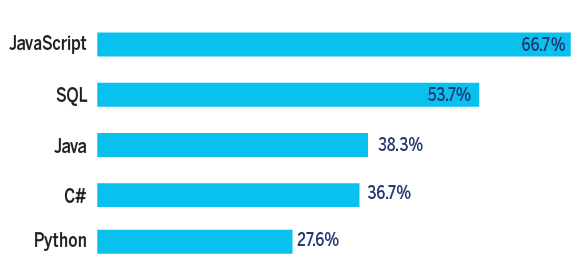
When one asks if React Native is better than Xamarin, the answer to the question lies here.
As per the lists shown by Facebook, there are over 200 apps that have been developed with its structure while many companies are migrating towards it.
Furthermore, due to its effectiveness, the React Native developer community is growing contrary to the expectation as over 1.6K contributors have committed code to this framework’s codebase.
React Native has new releases every two weeks, which means the developers get the latest features quickly. The project has over 61K stars, which makes it one of the most-starred GitHub Repos.
When one asks- what is the difference between Ionic and Xamarin, the clarity to the question is mentioned below-
Ionic is free and open-source that offers a whole library of mobile-optimized CSS, JS, and HTML components to build highly interactive applications. They have a motto-” write once, run everywhere” which implies that PC-based codes can also be run on any device. This practice allows software developers to save efforts by creating a single version of the software for all the platforms they intend to deploy on.
‘And it’s completely framework-agnostic at the core, fulfilling our original mission to be, first and foremost, a UI library for web developers no matter what frontend tools or frameworks they decide to use.’
Adam Bradley, Co-creator ad lead developer of Ionic Framework
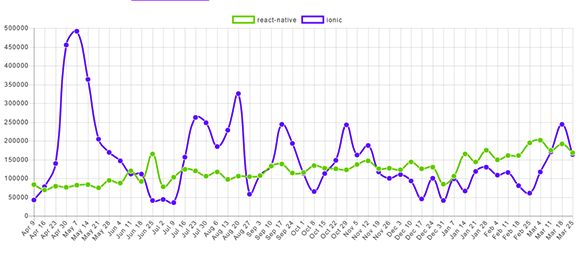
As per the Stats, there are around 5M ionic devs that too in over 200 countries worldwide. Over 75% of them use it for building apps for commercial use whereas around 41% are writing on behalf of their clients while 33% develop an application for their organization.
McDonald’s and Diesel also built their application using ionic, and also, it was chosen for developing Microsoft Flow and The National Museum of African American History and Culture mobile applications.
Let us now figure out what is Xamarin and how does it work?
Owned by Microsoft in 2016, Xamarin allows mobile app developers for using their pre-existing codes, tools, and libraries in C# for creating apps for iOS and Android mobile devices. The community of users has grown across 120 nations with over 1.4 million developers.
If a question like which is better ionic or Xamarin occurs, the following mentioned examples throw some light on it.
Companies like Slack, Pinterest, and Siemens also use Xamarin as their app-building tool. Also, it has been used by over 15,000 companies in the field of energy, transport, healthcare, etc.
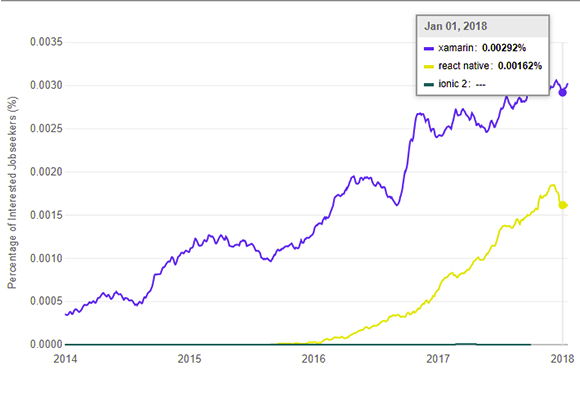
Before going into details, let us quickly look at the difference between React Native vs Ionic vs Xamarin-
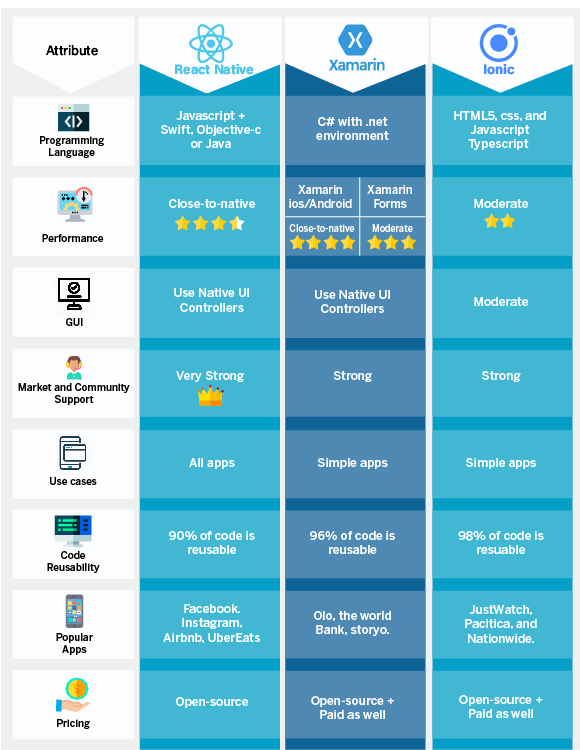
To decide which cross-platform mobile app development is better or say mitigating the disadvantages, let’s first define the attributes that can help you to decide about who is winning the race.
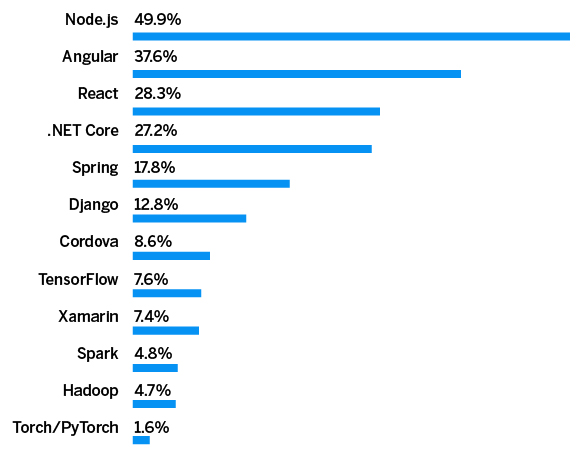
Statically typed language and the .NET framework for the mobile platform, it uses C#. also, there are a variety of .NET libraries available in the app development market. With it, a similar result can be achieved when using Java, Swift, and Objective-C.
To get the results, developers will be required to bind native open-source libraries that are available for iOS and Android with Xamarin. However, many of the pre-existing open-source and in-house source code projects can also be reused in Xamarin.
Questions like is React Native better than Xamarin confuse you, just understand that React Native’s JavaScript is known as one of the most popular high-level, dynamic programming languages.
Due to this, around 69.8 % of mobile app developers use JavaScript which indicates that finding a React native mobile developer will be easy.
If you are still confused about the question- is Ionic better than React Native, well the reality looks like this- the Ionic framework uses web technologies like HTML5, CSS, and JavaScript to write and run applications. Also, Ionic’s main programming language is TypeScript which is generally known as the superset of JavaScript. TypeScript increases the quality of the code as it helps in spotting and eliminating mistakes throughout the code typing.
it suggests two approaches for building mobile applications-
Xamarin Android and Xamarin iOS
Xamarin.Android/iOS apps behave like native due to the cross-platform capabilities that are focused mainly on sharing business logic rather than codebase. Also, they use native user interface controls and leverage platform-specific hardware acceleration. Thus, it helps in achieving the close-to-native performance that can’t be fulfilled with a solution interpreting the code at runtime.
Xamar in Forms
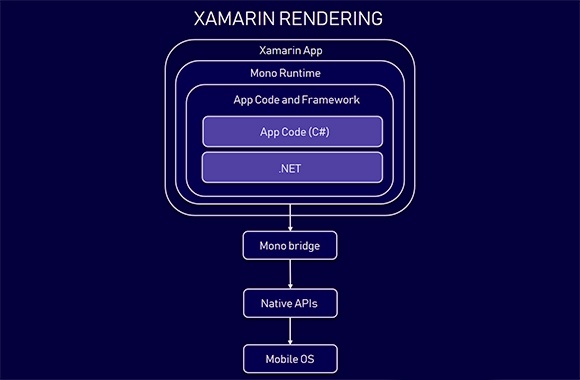
Xamarin.Forms are concentrated on broad code sharing and around 96% of source code can be reused with it.
Though its performance is quite closer to native, it renders code components directly to the native APIs using the JavaScriptCore virtual machine for both Android and iOS. React also allows for using native iOS and Android modules written in Objective-C and Java.
Also, these modules can not be reused across the two platforms as their main purpose is to achieve tasks that aren’t included in cross-platform JavaScript APIs.
React Native applications can share 80–90 % of JS code.
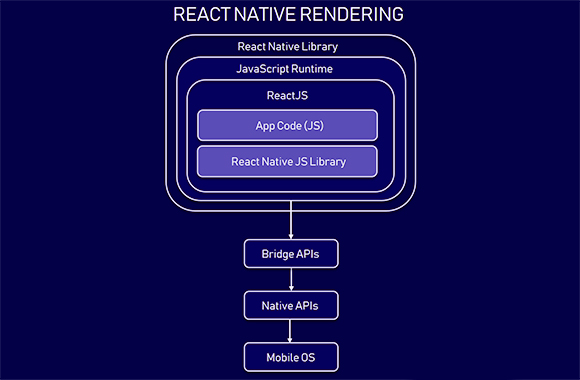
The answer to the question of what is Ionic and how it work is- Ionic uses web technologies for rendering applications and also, it does not use native components while trying to replicate native behavior when using web technologies.
To connect the app with native APIs, Ionic uses the native wrapper Cordova and adapts app behavior to the underlying platform.
Though it lacks somewhere it also has a strong side and that is its fast testing process. It can run instantly in a browser. In addition to this, the framework also comes up with pre-made and pre-styled components for streamlining the development cycle.
However, Ionic can’t achieve performance results comparable to React Native and Xamarin on complex and rich applications.
The different capabilities of these frameworks highlight why developers choose Ionic vs React Native vs Xamarin to start their projects with.
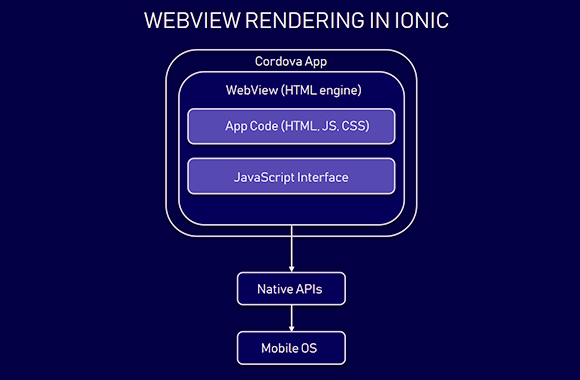
Xamarin similar to its two approaches, also allows developers to create the user interface in two ways- using Xamarin.Android/iOS or Xamarin.Forms.
Xamarin.Android/iOS-
The first approach involves working on the native platform-specific UI. mobile app developers can create a graphical user interface with native UI controls and layouts.
No doubt, the approach consumes a good amount of time but its division ensured a native feel and look to a mobile app.
Xamarin.Forms
The second way is to use Xamarin. Forms that automatically map each page while controlling platform-specific interface elements at runtime. With it, the development process is faster and thus saves a lot of resources. They are quite suitable for Corporate and internal projects.
React Native modules interact with native iOS and Android UI controllers that enable user experience close to native apps.
By using the ReactJS library with extensive UI components, it can streamline the whole UI development. Hence, React Native has many UI components that are out-of-the-box like modules, sliders, and buttons that ultimately help the app developers to work faster.
As it does not contain a native component, it renders everything in HTML and CSS. Once done it applies Cordova for recreating native mobile app behavior.
Furthermore, it comes with new native-styled UI elements and layouts that did not exist on the web earlier.
As per the GitHub statistics, React Native is the most starred framework with 69.3 thousand stars whereas Ionic took second place with 35.5 thousand and Xamarin the last place with only 5 thousand for all of its three repositories. (i.e. Xamarin. Forms, Xamarin.iOS, and Xamarin.Android).

According to Stack Overflow’s latest technology overview, using Cordova at its core, Xamarin is used by 7.4 % of mobile app developers.
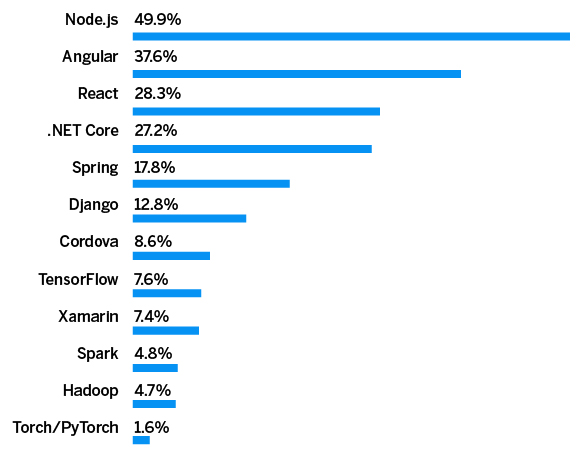
Microsoft invests a lot of effort and hard work in growing and educating the Xamarin community. Due to active support by Microsoft, developers can work within the Microsoft ecosystem.
Because of community support, developers with React Native can easily get answers even to ordinary questions, also, there is a large community that has created a recognizable number of third-party libraries.
The possibility of achieving greatness and in-built functionalities made the competition between React Native vs Ionic vs Xamarin stiff and challenging.
According to the 2017 Ionic Developer Survey, the growth of the ionic community is appreciable. In it, there is a special Q & A Ionic Forum that makes developers ask questions and receive the answers or sometimes advice also.
In addition to this, Ionic offers a Slack channel with a Slack community that makes the developers collaborate with other experience Ionic engineers and developers around the globe. With it, it is gaining a good portion of its market share by partnering with Webjunto, Spatial Vision, and Keensoft.
Developers will be required to have Visual Studio to develop, build and debug applications. It is the most popular and robust IDE if developers work with C# or. NET-related projects.
It also contains a code editing mechanism, and a simulator for trying the developed app and can also be significant on VS App Center for testing applications on various devices in a cloud.
You can use Visual Studio Code in it, a free distributive by Microsoft. For example- developers will be required to perform some tricks for debugging from Visual Studio Code directly.
But the most common and popular way of debugging is straight from the Chrome browser.
For further debugging on devices and building applications, developers will be required to have tools integrated with Ionic like Java JDK, Android Studio, and updated Android SDK tools for Android. Also, for iOS, developers will be required to use Xcode on iOS devices, Apple ID, and also on a Mac Machine.
It is somehow similar to Ionic regarding the coding and building process. In it, developers can use Visual Studio Code, WebStorm, ALM, and Atom, while setting up the same environment to debug on a device and deploy to app stores.
Under the MIT license, it has become an open-source framework. Though it is free but still developers will be required to install Visual Studio IDE, which is distributed on a subscription basis.
It is also available for free for the non-entrepreneurial project with up to 5 users whereas some of its features are locked behind Professional and Enterprise licenses.
It is an open-source framework and can be easily used by developers along with its free libraries.
Being an open-source framework at signup and during the development phase. Also, there is a companion platform Ionic Pro that comes in three packages- developer, team, and business. In addition to this, the subscription cost varies per month while offering additional features like error history tracking packages and collaboration tools for managing ionic work on larger teams.
So, this was all about the most commonly used framework and a tale of a rivalry between React Native vs Ionic vs Xamarin and their backstory. If you are also planning to develop an app, get in touch with us.
We develop apps by using the best and trending framework to make your dream app idea into reality.
Within the dynamic realm of mobile app development, the selection among Ionic, React Native, and Xamarin hinges significantly on the specific needs of your project, budget constraints, and the intended audience. Each framework presents unique merits and factors to weigh. Ionic stands out for its cross-platform capabilities, emphasizing robust utilization of web technologies. React Native excels in providing a performance akin to native apps and boasts an extensive developer community. Meanwhile, Xamarin distinguishes itself by seamlessly integrating with Microsoft technologies. Additionally, for those seeking comprehensive Xamarin development services, the framework proves to be an advantageous choice, aligning seamlessly with a range of project requirements. To make the most informed decision, it’s essential to weigh these factors against your project’s needs. If you’re looking for expert guidance and assistance in harnessing the potential of React Native or any other framework, consider partnering with Appventurez, a trusted and experienced React Native app development company. Their seasoned team of professionals can help you navigate the complexities of mobile app development and bring your app idea to life with precision and efficiency.


Elevate your journey and empower your choices with our insightful guidance.

VP – Pre Sales at Appventurez
Anand specializes in sales and business development as its VP - Sales and Presales. He supervises the pre-sales process by upscaling on establishing client relationships. He skillfully deploys instruments such as cloud computing, automation, data centers, information storage, and analytics to evaluate clients’ business activities.
You’re just one step away from turning your idea into a global product.
Everything begins with a simple conversation.